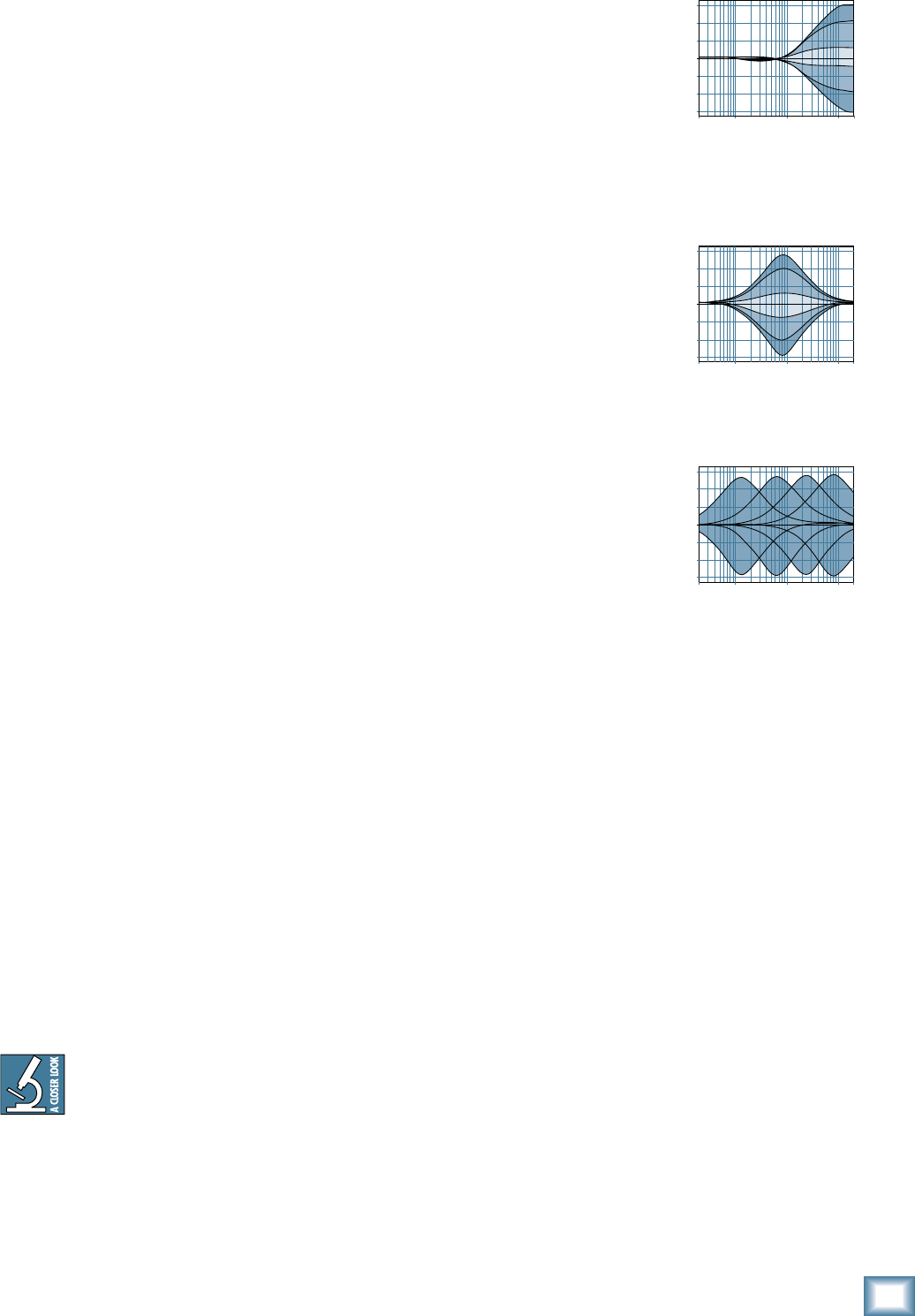
17
Owner’s Manual
Owner’s Manual
21. MON 1
This control allows you set up a nice monitor mix,
independent of the main mix or the monitor 2 mix.
Adjust these controls on each channel until your band is
happy with the stage monitor mix. The controls are off
when turned fully down, deliver unity gain at the center
detent, and can provide up to 15 dB of gain turned fully
up. Adjustments to the channel level or main mix level
will not affect the monitor output, but channel EQ and
gain [32] will.
One of the powered mixer's internal amplifi ers can
power passive stage monitors if you set the power amp
mode switch [4] on the rear panel. Mon 1 send [17] is a
line-level output if you want to connect external power
amplifi ers and passive stage monitors, or powered stage
monitors.
22. FX/MON 2
These controls allow you to send a sample of each
channel's signal to the internal FX processor, and to the
FX/mon 2 line-level output [15] to run external proces-
sors, or a second set of stage monitors.
Carefully adjust each control to set up the FX or moni-
tor 2 mix. The controls are off when turned fully down,
deliver unity gain at the center detent, and can provide
up to 15 dB of gain turned fully up.
The dual nature of this knob (FX or mon 2) is deter-
mined by the setting of the FX send /mon 2 send switch
[51]. More FX/mon 2 details are shown on page 14 and
page 23 (item 51).
CHANNEL EQUALIZATION (EQ)
The PPM1008 mono channels have 3-band equaliza-
tion: low shelving, mid peaking with adjustable frequen-
cy, and high shelving. The stereo channels have 4-band
EQ: low shelving, low-mid and high-mid peaking, and
high shelving. It’s probably all the EQ you’ll ever need!
Shelving means that the circuitry boosts or cuts all
frequencies past the specifi ed frequency. For example,
the low EQ boosts bass frequencies below 80 Hz and
continues down to the lowest note you never heard.
Peaking means that certain frequencies form a “hill”
around the center frequency.
With too much EQ, you can really upset
things. We’ve designed a lot of boost and cut
into each equalizer circuit because we know
that everyone will occasionally need that. But
if you max the EQ on every channel, you’ll get mix mush.
Equalize subtly and use the left sides of the knobs
(cut), as well as the right (boost). If you fi nd yourself
repeatedly using full boost or cut, consider altering the
sound source, such as placing a mic differently, trying a
different kind of mic, changing the strings, or gargling.
23. HIGH EQ
The high EQ provides up to 15
dB of boost or cut above 12 kHz,
and it is also fl at at the detent.
Use it to add sizzle to cymbals,
an overall sense of transpar-
ency, or an edge to keyboards,
vocals, guitar and bacon frying. Turn it down a little to
reduce sibilance or to mask tape hiss.
24. MID EQ LEVEL (Ch. 1 to 6)
The mid knob sets the
amount of boost or cut, up to
15 dB, and is effectively by-
passed at the center detent.
The frequency at which the cut
or boost occurs is set by the
frequency control [25].
25. MID EQ FREQUENCY (Ch. 1 to 6)
This knob sets the center
frequency of the mid EQ control
[24]. This is sweepable from
100 Hz to 8 kHz.
Once this is set, the mid EQ
level can be adjusted with the
mid EQ level control [24].
Most of the root and lower harmonics that defi ne
a sound are located in the 100 Hz–8 kHz frequency
range, and you can create drastic changes with these
two knobs. Many engineers use mid EQ to cut midrange
frequencies, not boost them. One popular trick is to set
the mid fully up, turn the frequency knob until you fi nd
a point where it sounds just terrible, then back the mid
down into the cut range, causing those terrible frequen-
cies to disappear. Sounds silly, but it works. Sometimes.
26. HIGH MID EQ LEVEL (Ch. 7 and 8)
The high mid EQ provides up to 15 dB of boost or cut
at 2.5 kHz, and it is also fl at at the detent. This control
is only available on stereo channels 7 and 8.
27. LOW MID EQ LEVEL (Ch. 7 and 8)
The low mid EQ provides up to 15 dB of boost or cut
at 400 Hz, and it is also fl at at the detent. This control is
only available on stereo channels 7 and 8.
28. ICE CREAM DISPENSER
This control is not there. It was going to be, but after
much discussion among the engineers, it was decided
not to add it after all. It would have been good though.
20
Hz
100
Hz
1k
Hz
10k
Hz
20k
Hz
–15
–10
–5
0
+5
+10
+15
20
Hz
100
Hz
1k
Hz
10k
Hz
20k
H
z
–15
–10
–5
0
+5
+10
+15
20
Hz
100
Hz
1k
Hz
10k
Hz
20k
Hz
–15
–10
–5
0
+5
+10
+15


















